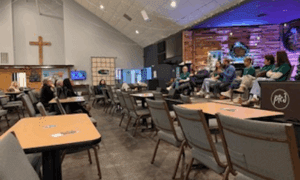The Fayette County Board of Education on Dec. 1 heard a potential proposal that could bring video and audio monitoring and instructor enhancement to classrooms in the county’s schools. If approved sometime in 2015, the pilot project would outfit one elementary, middle and high school with the SAFE system at a cost of $4,000 per classroom. The cost for the pilot program would be about $720,000.
The advantage of the teacher-controlled system is two-fold, staff said. It will allow a teacher to video a classroom lesson to increase professional learning and it will serve as a system to alert school staff and others to behavioral or other issues that require a quick response.
“(The) infrared wireless microphone system placed in the classroom environment evenly distributes the teacher’s voice throughout the classroom so students can hear more clearly. The teacher wears a microphone around the neck and can speak in the ‘natural voice’ – it is filtered evenly through multiple speakers in the classroom,” Deputy Superintendent Sam Sweat and others said in a Nov. 13 letter.
Among other instructional uses, teachers can record their lesson using the microphone/camera system and share their lesson with colleagues to improve teaching thus increasing professional learning at the school level. This integrated system encourages collaboration and sharing of instructional practices through an audio/video system. The teacher is in charge of the audio/camera system in their classroom. Recording a lesson and viewing it afterwards can be a powerful tool for self-reflection and improvement of instructional practices, the letter said.
Among the system’s security uses, the camera system provides the user with a single-view, double-panorama view (180 degrees) and a four-quadrant mode (360 degrees) view.
The large pendant-type microphone the teacher wears has an alert/panic button on it so if there is a problem or emergency, the teacher can press the alert button and instantly a camera is turned on in the classroom with audio/video and the front office is notified immediately. An email and/or text with a picture can be sent out at the same exact time to administrators and law enforcement personnel, staff said.
Staff said each classroom could be outfitted with a complete audio, video, alert and custom software package for security surveillance 24/7 monitoring (motion sensing). The cost per classroom is $4,000.
Staff noted that the use of the system in Newton County schools has resulted in fewer disruptions.
The system “provides a ‘natural view’ of the student in the classroom if their behavior is a concern. This type of natural view has the added possibility of assisting educators with response to interventions. If there is a behavior disruption which is serious, the teacher can press the alert/panic button and help is much faster to arrive because of the immediate notification to the front office and or administrators,” the letter said.
Beyond the classroom, the SAFE system can be installed strategically throughout the school for high-traffic student areas (cafeteria, front office, commons area, gym) so that a staff member can push the button and the audio/video system begins recording and the automated notifications are sent out immediately.
Staff noted that middle and high school hallways already have cameras installed.
Sweat, Assistant Superintendent Terry Oatts and other presenters at the Dec. 1 meeting advocated for the school board to authorize a pilot program in 2015.
Superintendent Jody Barrow during the presentation said the SAFE system is one element of the Connected Classroom model.
“There will be other (elements) we’ll bring (to the board) over the next few months,” Barrow said.
If implemented, the project, or portions or it, could be eligible for funding from E-SPLOST (Education Special Purpose Local Option Sales Tax) revenues.
Fayette schools contain about 1,260 classrooms, according to officials — 560 classrooms in 14 elementary schools, 300 in five middle schools and 400 in the county’s five high schools. To equip all of them with cameras would cost over $5 million.












Leave a Comment
You must be logged in to post a comment.